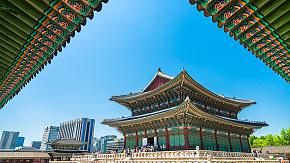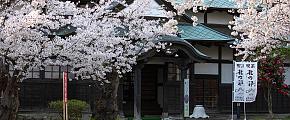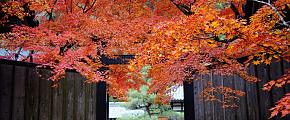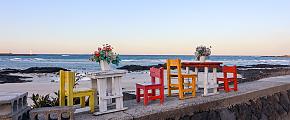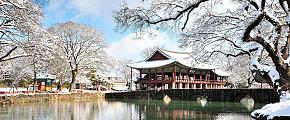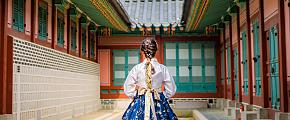Guide to Hanbok in South Korea: Culture & History
Korean wave (Hallyu) has become a popular cultural phenomenon since the 1990s because of K-drama and K-pop music. Hanbok as the traditional costume, also become one of the experiences when traveling to South Korea. To better understand hanbok, we will introduce the history of hanbok, types of hanbok, and more interesting and useful tips for you. Let's get started.
What Is Hanbok
Hanbok (한복; 韓服) means Korean clothes, so-called since the end of the 19th century to distinct from western clothes, is the traditional clothes of Korean people with over 2000 years history.
Traditionally, hanbok is made from natural fabrics such as silk, cotton, and hemp. Hanbok is cut and sewn flat. Consists of an upper garment (jeogori) and lower garments: trousers for men (baji), and long skirts for women (chima), the tops are wrapped and tied together with a one-looped bow (goreum).
There are also many exquisite accessories that make the hanbok more elegant. Norigae is a delicate ornamental tassel. Daenggi is a thick ribbon used to decorate a lady's hairstyle. Binyeo is also a hair decoration to hold women's hair bun together, which are pins made of wood, jade, gold, or animal bones.
Different colors symbolize different social positions and marital statuses in South Korea. The upper classes wear a variety of colors and magnificent clothes. By comparison, the working class were required to wear white tops and dress in pale pink, light green, grey, and charcoal bottoms.
Children usually wear bright colors, and men and women of middle age wear soft colors. Unmarried young women usually wear yellow jeogori and red chima, whereas married women wear green and red. Women with sons dress in navy.
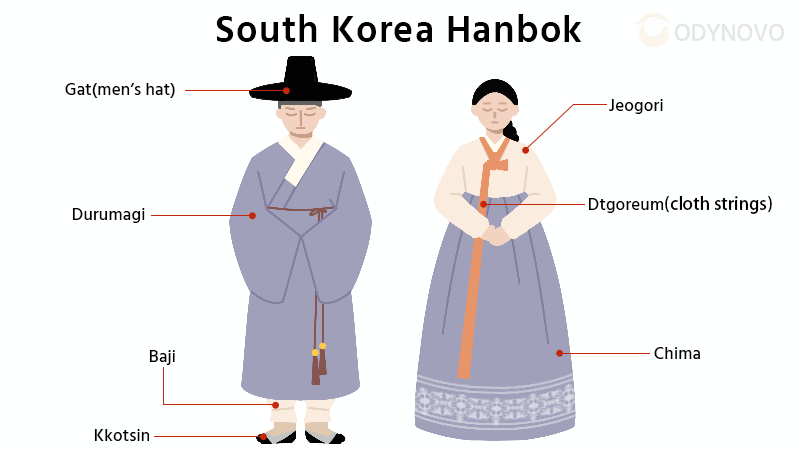 Hanbok in South Korea
Hanbok in South Korea
History of Hanbok Evolution
Three Kingdoms Period
Hanbok's roots can be traced back to the Three Kingdoms period (57 BC to 668 AD) of Korean history. During this period, the clothing style is influenced by neighboring countries like China and Japan. Hanbok was worn in different ways and with different materials at that time.
Unified Silla Kingdom
With the help of the Chinese Tang Dynasty, the smallest of three kingdoms Silla conquer other two empires. The Unified Silla Kingdom (676 CE -935 CE) connects closely with the Chinese Tang Dynasty, which deeply influenced the clothes style of this period. It is different from any other time in the history of Korean clothes.
Goryeo Kingdom
Goryeo Kingdom (918 - 1392) took control of this land after the Unified Silla Dynasty collapsed. In this period, the clothing style was influenced by the Mongol Yuan Dynasty. The clothes were made more comfortable for horseback riding.
Joseon Dynasty
The clothes style in the Joseon Dynasty (1392 - 1897) developed the form of the standard "hanbok" as today. Hanbok of men and women has become more different than in the past. Women's jeogori (top jacket of hanbok) changed to shorter and shorter in this period. Men's clothing styles were almost the same in this dynasty. However, men usually wear hats (kat 갓) as necessary accessories when going out.
Korean Empire
In the past history of Korea, hanbok is just daily wear clothes. After King Gojong founded the Korean Empire (1897 - 1910), the controversy and divide between Western uniforms and traditional hanbok deepened as time progressed. This is when the phrase 'hanbok' appears, to be better distinct from Western clothes.
Colonial Period
From 1910 to 1945, this land was annexed by Japan. The colonial government allowed Koreans to wear traditional clothes but criticized the hanbok as bagginess and easily to be soiled. In this period, the clothes Koreans wore were forced to be dyed navy or black. Western clothes were considered as symbols of wealth, progress, and modernity while hanbok was associated with poverty, backwardness, and tradition.
Modern Korea
After 1945, Korea got rid of the colonial of Japan. However, South Korea was busy with rebuilding the infrastructure and industrializing for a long time due to the Korean War. As war relief, Western clothes become the mainstream of Korean clothes. Hanbok almost disappeared at this time. It re-emerged in the 1970s-1980s as formal ceremonial wear. And everyone can wear any kind of hanbok, even royal clothes.
Hanbok at Present
In recent years, more and more designers have focused on hanbok design. You can not only see the traditional types but also some lifestyle hanbok, combining hanbok elements with modern clothes. It has become the new trend of hanbok.
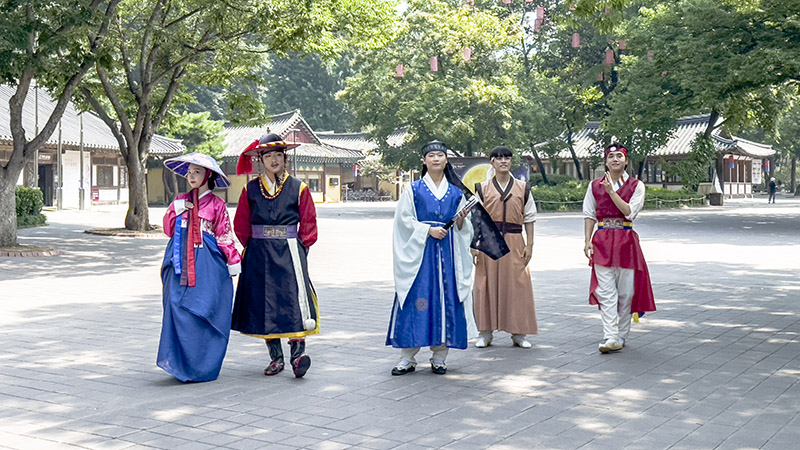 Different Types of Hanbok
Different Types of Hanbok
Hanbok Experience: Rental and Shopping
You may be curious about these questions: "Can I wear a hanbok", "Where can I rent a hanbok", and "Where can I buy a hanbok". In this section, you will find the answer.
Rental hanbok has become very common in South Korea. Especially when the cherry blossoms are in full bloom, there will be many youngsters wearing traditional hanbok to take photos or picnics under the cherry trees.
You can choose a favorite store and just walk in. If you are interested in owning your own hanbok to keep as a souvenir, you can shop in some hanbok toggeries or customize your hanbok depending on your own preference. Nowadays, it is no longer everyday wear, hanbok is more likely to become formal clothes in South Korea for certain situations such as wedding ceremonies, birthdays, and more. You can find some hanbok customized stores with good quality to design and tailor-make your own hanbok for some formal situations. Also, some unique hanbok brands design both formal and daily lifestyle hanbok.
Rental Hanbok
There are many hanbok rental stores in South Korea. You can find one in most of the main attractions in South Korea, even in airports. You can choose one depending on your own preference and it can provide rental hanbok service from hours to days at different prices. The price is about 10,000 to 20,000 Korean Won per hour, usually including hanbok, bag, and hairstyle. You can choose a hanbok rental only, or choose some photography sets, including a professional photographer taking certain numbers of well-retouched photos for you. It all depends on your preference and needs, you can decide after comparing some hanbok rental shops in South Korea.
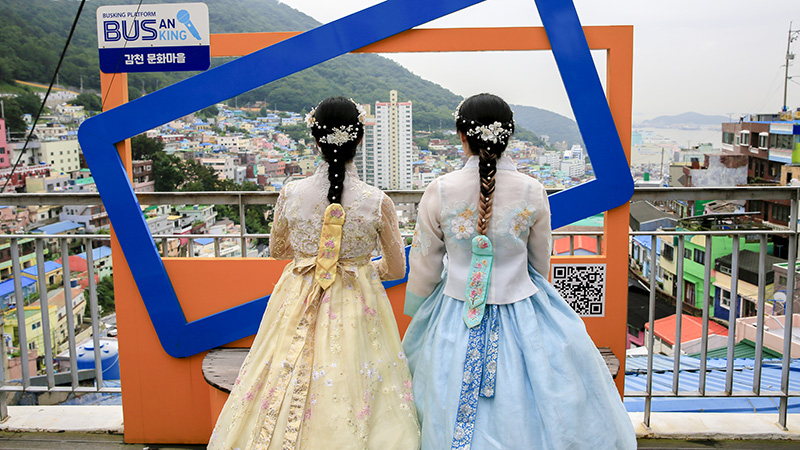 Rental Hanbok
Rental Hanbok
Shopping at Lifestyle Hanbok Brands
More and more young designers are interested in adding hanbok elements to their designs. There are many fashion hanbok brands you can find in every city in South Korea. For example, LEESLE is a pioneer lifestyle hanbok brand based in Jeonju. The designer creates the jeogori and chima separately but not as traditional sets. Customers can choose the collocation by themselves. Kustom Bidan Hanbok is another novel brand for customizing hanbok. Located within walking distance from Seoul station, you can explore the showroom by yourself.
Travel Tips
Free Entry to Palaces in Seoul
If you are wearing a hanbok and want to travel around Seoul, remember hanbok is free admission to palaces in Seoul, including Gyeongbokgung Palace, Changdeokgung Palace, Gyeonghuigung Palace, Deoksugung Palace, and Changgyeonggung Palace.
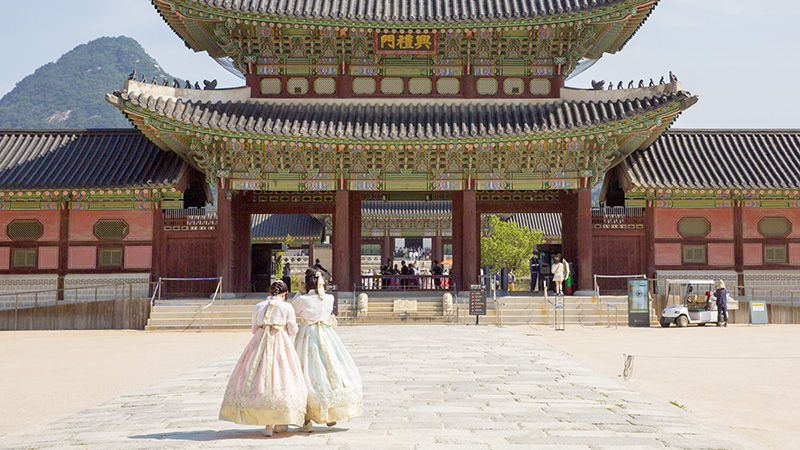 Visit Palace With Hanbok
Visit Palace With Hanbok
Book in Advance
If you are interested in rental hanbok when traveling to South Korea, you can book a reservation in advance to get a better price. You can check the hanbok style and quality by viewing the profile and comments of rental hanbok shops.
Be Respectful
Please remember to be respectful of hanbok and the local culture. When wearing a hanbok while traveling in South Korea, be careful about your manners.
Customize Your South Korea Tour With Odynovo
South Korea is a dynamic country and it is very convenient to combine a tour with other Asia countries. Wherever you want to go and whatever you wanna experience, Odynovo will be dedicated to satisfying your needs. If you are interested in wearing a hanbok to travel around South Korea or customize your own hanbok, feel free to contact us or send to [email protected] for further information.
Related Posts You May Like
What Our Clients Say
Explore the latest verified reviews of Odynovo's travel services on Tripadvisor, Google, Trustpilot, Product Review and more trusted platforms.

